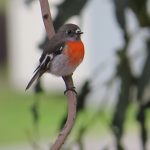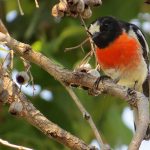SCARLET ROBIN
The Scarlet Robin displays sexual dimorphism, meaning males and females have different plumage. The male has a distinctive black head, back, and wings, with a bright scarlet breast and upper belly. The female has a brownish-grey head, back, and wings, with a pale buff-colored breast and belly. Both sexes have a white patch on their forehead, which contrasts with their dark facial markings.
The Scarlet Robin is found in various habitats across south-eastern and eastern Australia, including open forests, woodlands, and heathlands. They are commonly found in regions of New South Wales, Victoria, Tasmania, and south-eastern Queensland. They are migratory within their range, moving to lower altitudes during winter.
Scarlet Robins are known for their distinctive hunting behavior. They perch on low branches or tree stumps, often in open areas, and watch for insects and other small invertebrates on the ground. They have a habit of hovering momentarily in the air before pouncing on their prey. They also feed on berries and other fruits when available.
The breeding season for Scarlet Robins typically occurs from August to January. They build cup-shaped nests made of grass, bark, and other plant materials, usually located in a tree hollow, stump, or the fork of a tree. The female lays around 2-4 eggs, which she incubates for approximately two weeks. Both parents participate in raising the young, feeding them and protecting the nest.
The Scarlet Robin is currently listed as Vulnerable in NSW , like many bird species, they face threats from habitat loss, climate change, and introduced predators. It’s important to protect their habitats and maintain the ecological balance necessary for their survival.
To help this species and many others to survive :
- Retain existing forest, woodland and remnant grassland vegetation, including paddock trees.
- Retain dead timber on the ground in open forest and woodland areas.
- Enhance potential habitat through regeneration by reducing the intensity and duration of grazing.
- Fence remnants to protect from long-term, intense grazing.
- Increase the size of existing remnants, by planting trees and establishing buffer zones of un-modified, uncultivated pasture around woodland remnants.
- Keep domestic cats indoors at night; desex domestic cats; assess the appropriateness of cat ownership in new subdivisions adjacent to Scarlet Robin habitat.
- Avoid the use of exotic berry-producing shrubs in landscape and garden plantings in areas adjacent to Scarlet Robin habitats.







